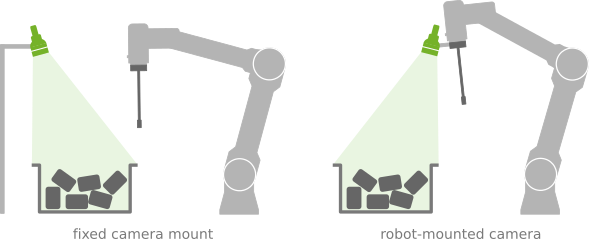Warning
You are reading the documentation for an older Pickit release (2.3). Documentation for the latest release (3.5) can be found here.
What is the ideal distance to mount the Pickit camera?
The distance between the camera and the parts to detect plays an important role in getting high-quality detections out of your Pickit system. The following guidelines will help you to find the camera mounting distance that works best for your application:
The distance between the camera and the objects to detect should be within the minimum and maximum values documented in the camera specifications (M-HD, M, L).
When objects can be at different heights, such as when emptying a bin, make sure that the closest objects (full bin) are not closer than the minimum distance to the camera, and that the furthest objects (almost empty bin) are not farther away than the maximum distance to the camera.
When objects can be at a height range that exceeds the depth range of the camera, as can happen in depalletizing applications, it is recommended to mount the camera on the robot and to move the detection pose down as the height of the stack decreases. The idea is to preserve a similar distance to the camera for all stack layers.
Taking into account the above constraint, the camera should be as close to the objects as possible, while still capturing the desired field of view.
Moving the camera closer to the objects produces more detailed captures of the scene, which leads to more precise detections.
Moving the camera away from the objects allows capturing a bigger the field of view.
When the application requires a field of view greater than what the camera can provide, as can happen with very wide bins, it is recommended to either use multiple cameras, or mount the camera on the robot and cover the entire surface with multiple detection poses.
Note
After positioning the camera, make sure that it is rigidly fixed to the mounting structure or robot. In particular, if you use the ball joint that ships with your Pickit camera, make sure to tighten the screws that lock it in position.
Vibrations caused by robot motions or other machines operating nearby might cause the camera position to slightly change, invalidating the robot-camera calibration and resulting in picking errors.
Robot position during image capture
When object detection takes place, the robot should be located in a position that is adequate for image capture, which depends on how the camera is mounted:
For a fixed camera mount, the robot should not occlude the camera view, and the expected robot motions should not collide with the camera.
For a robot-mounted camera, the robot should be placed in a way that the above distance recommendations hold.
